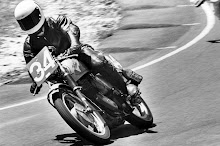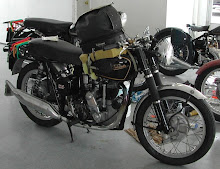Its been some months since I did my last post early in December 2015 and the next major one I'm planning on the Velocette VMT is taking some time to assemble, so I decided to do an interim post on the preparation of a new speedometer/tachometer dial face for a motorcycle...similar for a car....using the screen printing process.
But first....I'm happy to answer questions on dials and their printing, BUT I sold on this business to others....Howard Instruments in Melbourne, Victoria.....so can't supply any dials.
Lets look at some motorcycle dial faces that are common to be replaced with reprinted dials......
Chronometric motorcycle speedometer dial...the Smiths logo type indicates it was used in the period 1947-1958.
Four prewar dial faces...in this case illustrated from pre WW2 Vincent motorcycles, but used on other pre WW2 British motorcycles. The Smiths logo is the "shield" logo which was discontinued around 1946. For a concours motorcycle that is made prewar, its Smiths speedometer and tachometer must have this "Shield" logo to be correct.
Triumph Motorcycles use the Smiths "Revolator" dial face on their chronometric instruments from 1939 to about 1960 which had internal coloured bands for use as a tachometer as well as a speedometer. Illustrated are the 650cc type...note the 4th gear ring has a "70" = 7000rpm in the region of 116/118mph. The 500cc Triumph used another Revolator dial with the "70" around 109mph.
Smiths introduced new, replacement instruments for British motorcycles for the 1964 season. 80mm diameter they were not of the chronometric principle of operation that had been the norm from around 1927 to the end of 1963, but used the "eddy current" magnetic principle. Smiths called the speedometer the SSM...Speedometer Shallow Magnetic and the tachometer the RSM, Revcounter Shallow Magnetic.
Both the chronometric and the SSM used different dial blanks....
You can remove paint from existing dial faces and re-paint them with a form of matt or satin black as the background.
Or if you are into quantity as I was, you can have blanks lazer cut from 0.7mm steel.
So lets look at the screen printing of these dial faces.
I don't intend to go into the procedure for getting the images onto the screen for subsequent printing.
Lazer cut dial blanks prepared for grey faced SSM speedometers.....
An original, if a bit used, grey faced RSM dial from a Velocette Venom Thruxton.
A view of the printing screen with the image I'm to print...
The prepared dial blank and the "female" carrier used to locate the dial under the screen in the exact position to print the image.Note the small tabs on the dial face to locate the dial in the carrier.
Use an existing dial with the same image on it ( in this case a dry but slightly damaged image...ok for our purposes) and locate it under the screen so when the screen is closed the image is exactly in line, then tape the carrier in place. When printing multiple numbers of dials the locating tabs on the lazer cut dial blanks locate into the opposite in the carrier and ensure the printed image will always be in the correct position on the dial blank.
To avoid mess all over the screen mesh it is best to cut a paper blanking cover and tape it completely around its cut edge. Then only ink will pass on to the exposed area of the dial image.
Ensure the screen mesh surface is set about 2-3mm above the dial blank to be printed on...this is called the "snap" and ensures the screen will move up off the dial as the squeegee blade delivers the ink on to the dial blank.
Prepare ink onto the edge of the squeegee blade...I use white enamel screen printing ink which gives a deposit on the dial that your eye can detect in a 3 dimensional way, rather than the thin image from other forms of screen printing ink. The screen mesh I use is 140 mesh and of course the ink manufacturers claim enamel ink won't print through it..they say a max. of 90 mesh.
Funny that, I successfully printed tens of thousands of dials in the many years I was doing my printing...The fine mesh ensures fine text can be printed.
Pull a flood pass of ink across the screen image without actually having the squeegee blade touch the screen surface...this leaves a coating of about a mm of ink over the surface.
Then starting on one side of the dial image pull the squeegee blade on the mesh firmly and smoothly across the image, thus ensuring ink is forced through the image on the screen and onto the dial blank below.
Open the screen to removed the printed dial...I use a knife blade located into the odometer slot to pop the dial out of the carrier and down on to a dish for subsequent slow drying. Enamel ink takes several hours to dry the image. Despite this, speed is the essence or some residual ink left in the screen image will start to dry out...so either fit another dial blank into the carrier and repeat the process as many times as you require dial quantities or immediately clean the screen image with mineral turpentine, the solvent for enamel ink. I usually place paper towel under the image and use a turpentine wet paper towel to scrub carefully across the image above until there is no evidence of ink in the screen image.
Place the finished printed dials on their tray into a dust free area to dry for several hours.....
Then of course the dial can be fitted into a restored instrument to make the speedometer look brand new....
A completed instrument I did, including print the special dial face for a customer at the time who rode a HD and liked Ned Kelly the famous Australian bush ranger in the 1800s...
Of interest...how did Smiths print their dial faces?
They used an engraved image on a polished steel block and a gelatine block...the image on the steel block had ink to lightly coat into the engraved image and the gelatine block was pressed onto the image thus picking up the image onto the gelatin and pressed onto the dial blank.
Pictured below is the process scanned from a Smiths house magazine I have...the photo around 1934....
Subscribe to:
Post Comments (Atom)




































No comments:
Post a Comment